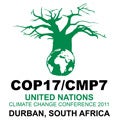 As COP17 enters its second week in Durban, the most striking element for me has come from outside the negotiating rooms: the clear sense of momentum around taking action on the ground, and doing so sooner rather than later. Countries are being opportunistic and seizing the day, while the global deal continues to be worked out. The driving force behind this action is the challenge of delivering on domestic priorities such as energy security and access; productivity and competitiveness growth etc. Lower emissions and the climate imperative are a welcome co-benefit but not the main goal. Nearly 90 countries have registered plans with the UNFCCC to address the emissions intensity of their growth by 2020. This includes more than 50 developing countries (a quarter of which are low-income countries) that are pushing forwards with Low Emissions Development (LED) through outlining nationally appropriate mitigation actions.
As COP17 enters its second week in Durban, the most striking element for me has come from outside the negotiating rooms: the clear sense of momentum around taking action on the ground, and doing so sooner rather than later. Countries are being opportunistic and seizing the day, while the global deal continues to be worked out. The driving force behind this action is the challenge of delivering on domestic priorities such as energy security and access; productivity and competitiveness growth etc. Lower emissions and the climate imperative are a welcome co-benefit but not the main goal. Nearly 90 countries have registered plans with the UNFCCC to address the emissions intensity of their growth by 2020. This includes more than 50 developing countries (a quarter of which are low-income countries) that are pushing forwards with Low Emissions Development (LED) through outlining nationally appropriate mitigation actions.
This demand for LED has prompted a ‘thousand flowers blooming’ supply of initiatives to support developing countries in their planning and implementation. On Saturday I attended a dialogue on LED hosted by the World Bank that was a genuine conversation and sharing of ideas on how to improve coordination i.e., shift the supply of support from resembling scattered flowers towards becoming the same flowering plant. More than a hundred delegates including senior negotiators, heads of organizations, think tanks, and country practitioners actively participated in the discussion.
Support is coming for all stages of the process from the tools and analysis through to policy and program development and piloting implementation. Many organizations (CDKN, GGGI, CPI, Africa Climate Policy Centre, UNEP Risø, ClimateWorks, CMCI, IDB, CCAP, The Climate Group) active in this space outlined their work and identified opportunities where they would like to see increased collaboration, coherence, and partnerships.
A new field needs new ideas and approaches – there is no correct/ ‘one size fits all’ way. So this surge in supply and experimenting is generating the much-needed learning and knowledge that can inform best practice going forward. But at the same time, there is patchy geographic coverage by the initiatives, potential for duplication and rising transaction costs for the countries ‘being supported.’ The discussion was significantly enriched by many countries, including Chile, Colombia, Germany, India, South Africa and UK, setting out what they are doing, the progress they have made, the support they have received and where they perceive the gaps to be. In other words, we had the opportunity to steer the ‘supply’ towards matching the ‘demand’ and foster and sustain a genuinely country driven momentum.
This discussion demonstrated the desire to enhance coordination and scale up targeted support for countries, while ensuring knowledge sharing and South-South learning. This now needs to be turned into reality. Between now and Rio+20 in June 2012, there are many more opportunities to continue this dialogue, sustain momentum, learn from each other, build political support for strengthened coordination, and most importantly demonstrate coordination at the country level. If this becomes the norm then we would go a long way towards making the sum greater than the individual parts.


Join the Conversation